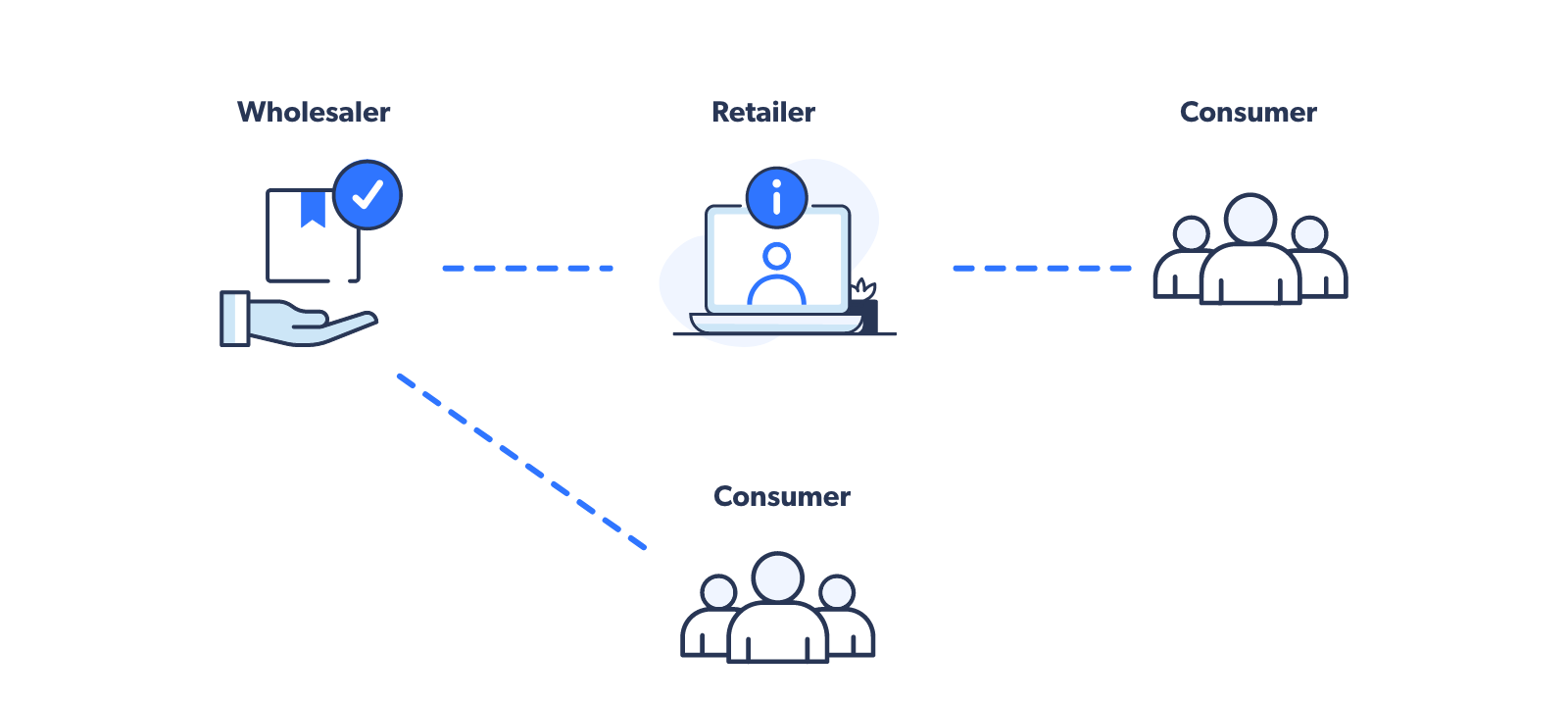
See why top ecommerce brands use Miva’s no-code platform to run
multiple stores, manage massive catalogs, and grow their revenue.
The B2B ecommerce market is booming, with Statista projecting US sales to surpass $3 trillion by 2027. This explosive growth is fueling a surge in wholesalers moving their catalogs online, and for good reason.
Whether you’re building an online wholesale store for the first time or are refining your existing site to make it more effective, this article will give you an overview of the state of modern B2B sales and guide you through the elements necessary to create a thriving wholesale ecommerce website.
Wholesale ecommerce is a type of B2B ecommerce business model where one business uses digital channels to sell products, in bulk quantities and at a significant discount, to another business. The buying business then sells those products on their own website at a higher price, typically to general end consumers. For instance, a wholesale B2B ecommerce company offering consumer packaged goods might sell snacks, toiletries, and other items to grocery stores or pharmacies.
In addition to traditional wholesale methods, wholesale ecommerce allows businesses to leverage online B2B ecommerce features to streamline their sales, marketing, and distribution.

Using a wholesale model offers many benefits for your business. Selling items in bulk often results in higher order volume, lower expenses due to lower cost-per-unit, and increased profit margins. Adding a wholesale channel also allows you to attract new customers and significantly expand your reach through the growing B2B market.
Your business can benefit even further by moving your wholesale channel online. By selecting the best wholesale ecommerce platform for your business, you can create a wholesale ecommerce website that helps you:
Whether you've just launched an online wholesale store or are refining your established ecommerce site to make it more effective, this article will give you an overview of modern B2B sales and guide you through the elements necessary to optimize your wholesale website for growth.
Let's start with the most important aspect of your strategy: your customers. A successful wholesale ecommerce website caters specifically to the unique needs of B2B wholesale customers. Today's wholesale buyers are often digitally connected and technologically savvy. They're used to shopping on digital marketplaces, conducting research online to find new products and compare options, and connecting with brands on social media.
These buyers will look for wholesale ecommerce experiences that mirror their online B2C or DTC shopping while meeting their business buying needs—meaning personalized, seamless, and user-focused websites emphasizing customer education.
There are four main types of wholesale buyers: retailers, manufacturers, distributors, and agents. The best way to think about each type of buyer is to consider what kind of consumer they are purchasing or negotiating prices for.

Before diving into optimization, it’s important to thoroughly audit your current ecommerce website. This exercise provides valuable insights into areas that require improvement. Here's a comprehensive approach to auditing your website:
Relevance: The first step involves assessing whether your content aligns with the needs and interests of your B2B audience. It should be informative, up-to-date, and tailored to wholesale buyers.
Freshness: Refresh your content by updating outdated information, optimizing product descriptions with relevant keywords, and adding new case studies and industry insights.
SEO Optimization: It's not just about keywords and meta descriptions. Let's say you're an e commerce wholesale distributor selling office supplies. Your keyword research might reveal that 'wholesale office supplies' is a popular search term among your target audience. By optimizing your title tags and meta descriptions to include this keyword, you can significantly improve your website's visibility in search results, leading to increased traffic and potential sales.
Content Gaps: This is an opportunity to identify areas where your content might be lacking and make significant improvements. Are there important product categories missing detailed information? Could you be creating more resources like white papers or blog posts to address industry challenges faced by your target audience? By addressing these gaps, you can enhance your website's value and appeal to your B2B buyers, potentially leading to increased conversions and customer satisfaction.
Website Speed: A slow website leads to frustrated buyers and lost sales. Ensure your website loads quickly across all devices. Here are four steps you can take right now to improve your website speed:
Security: Prioritize robust security measures. Implement SSL encryption to protect customer data and transactions. Regularly update your website platform and plugins to address any potential security weaknesses.
Mobile Responsiveness: As mentioned earlier, a mobile-first approach is essential. Verify that your website displays seamlessly across various screen sizes, with clear calls to action and easy navigation optimized for touchscreens.
Usability Testing: Engage potential customers who represent your target B2B buyer personas in usability testing sessions. Observe their behavior and gather feedback on navigation, search functionality, account management features, and overall ease of use. This active approach allows you to understand their needs and preferences directly, leading to more effective website improvements.
Heatmaps: Analyze user interaction on your website using heatmap tools to identify potential areas for improvement. For example, heatmaps might reveal that important information is located below the fold or that calls to action are not visually prominent enough.
Track Conversions: Set up website analytics to track key metrics like website traffic, conversion rates (percentage of visitors who complete a desired action, such as making a purchase or requesting a quote), bounce rate (percentage of visitors who leave your website after viewing only one page), and average order value. These metrics will provide valuable insights into user behavior and areas for improvement.
A/B Testing: This powerful technique allows you to compare different versions of website elements to see which ones perform better. For example, you could test different product page layouts, call-to-action buttons (e.g., "Buy Now" vs. "Request a Quote"), or checkout process options to see which variation leads to a higher conversion rate. By implementing these tests, you can be confident that you're making data-driven decisions to optimize your website's performance.

Now that you have a deeper understanding of your potential customers, here's how to lay the groundwork for a thriving online marketplace:
Let's say a B2B buyer is searching for bulk quantities of customized packaging supplies. Your wholesale e-commerce platform's UX should streamline this process. Here are some key features and functionality to consider:
Intuitive Navigation
Wholesale buyers typically arrive at a B2B ecommerce store already knowing what products they need to purchase. Your navigation should allow easy access to product listings, order tracking, account management features, and quick quotes. Create a user-friendly interface with clear menus and categories.
Advanced Search
B2B buyers often have specific requirements. Make it easy for them to get granular while searching your site. Implement robust search filters based on product attributes (size, color, material, minimum order quantity) and allow for complex searches that combine multiple filters to help wholesale shoppers find products quickly and easily.
Account Management
Virtually all B2B buyers now want self-service in their online shopping experience. Empower your wholesale buyers with self-service tools. Offer account dashboards that display order history, pricing structures (including quantity discounts), loyalty programs, and product favorites. Include features for easy reordering with pre-populated shopping carts, quick access to invoices and shipping information, and the ability to request quotes for customized products.
Mobile-First Design
B2B buyers are increasingly mobile. Ensure your website is responsive and offers an optimal experience on all devices, focusing on intuitive navigation and clear calls to action.
As much as we stress the importance of optimized product descriptions (seriously, we have blogs and downloadable guides dedicated to them), high-quality content is more than that. To stay competitive, B2B businesses need to prioritize content that educates, builds trust, and speaks to wholesale buyers at every step of the buying process.
Since B2B buyers are typically motivated by logic, education, and expertise, a strong wholesale ecommerce business will emphasize content in both its marketing strategy and its customer-facing website— and that’s where selecting a full-featured wholesale ecommerce platform comes in. Educational content such as blog posts, whitepapers, case studies, infographics, and more can position your wholesale brand as a visible and trusted authority, address any customer needs or objections, and guide prospective buyers on their path to conversion.
According to eMarketer research, check and cash payments fell from a majority share of B2B transaction value in 2019 to just 32.1% in 2024.
Offering your buyers flexible payment options is just as crucial in wholesale as it is in consumer spheres. While some B2B payment systems still rely on manual processing, digital B2B payments are becoming increasingly common, and if you don’t accept a buyer’s preferred payment method, you may risk losing them to a competitor who does.
To appeal to a wide range of buyers and to further optimize the path to checkout, your wholesale ecommerce site should accept common B2B payment types such as credit cards, ACH transactions, wire transfers, and digital wallets. You may also consider offering buy now pay later solutions for added flexibility. Finally, B2B quoting software makes it easy for customers to purchase from your wholesale site.
Despite the digital transformation of B2B, your sales team remains a vital part of your wholesale ecommerce strategy. Their unique understanding of your buyers' challenges and desired solutions is invaluable. They can help shape your business's approach to providing these solutions. Wholesale B2B ecommerce systems harness the speed and visibility of digital data, equipping your sales team with real-time information crucial for successful selling.
Ecommerce automation technology is changing the B2B sales process, reducing the need for manual labor. The increased efficiency delivered by a wholesale ecommerce platform can free your sales team, allowing them to expand their role in your ecommerce experience. They can now assist customers through digital and in-person channels, prospect new accounts, and strengthen existing client relationships.
While automation streamlines processes and empowers buyers with self-service options, the human touch of a skilled sales rep remains a vital component of success. Here's why your sales team is still an integral part of your B2B wholesale ecommerce strategy:
From Transactional to Value Selling:
Sales reps' roles have shifted from order takers to value advisors. Leveraging their expertise in your industry and customer base, they can identify buyer pain points and present your products or services as solutions that address specific needs and deliver a strong ROI. Equip your sales team with resources (industry white papers, customer success stories, etc.) to demonstrate the tangible benefits of your offerings.
Content Marketing Collaboration:
Sales reps aren't siloed entities; a powerful partnership exists between them and marketing. Sales reps with a finger on the pulse of customer needs can collaborate with the marketing team to create content that resonates with your target audience. This collaboration is crucial as it ensures that the content created is not only relevant but also effective in driving sales. This could include engaging blog posts addressing common industry challenges, insightful case studies showcasing customer success stories, or informative white papers offering in-depth analysis of relevant trends.
Data-Driven Insights for Smarter Selling:
Platforms that specialize in ecommerce for wholesale and B2B have tons of valuable customer data. The speed and visibility of that data empower your sales team with information crucial for successful selling:
By embracing ecommerce automation and a skilled sales team, your B2B wholesale business can keep pace with the evolving landscape and thrive in the digital age.

Now that you've equipped yourself with these powerful B2B wholesale ecommerce strategies, it's time to find the ideal platform to support your business and fuel growth.
While the lines between B2B and B2C features are blurring, mid-market wholesale brands have unique needs that require a platform built to accommodate them. Here are some important questions to consider when comparing ecommerce solutions to help identify the primary goals for your B2B business and determine which ecommerce partner is the best fit.
Can you personalize crucial elements like search functionalities, order forms, and product bundling options to mirror your buyers' specific buying preferences?
An online platform offering high customization ensures a seamless and efficient purchasing experience for your B2B customers.
Does the platform seamlessly handle large-scale orders and complex fulfillment processes?
As your business grows, your platform should be able to adapt and support bulk ordering without compromising efficiency.
Can you integrate your B2B sales with a potential B2C or D2C storefront on a single platform?
This allows for a unified omnichannel experience, streamlining operations and potentially attracting new customer segments.
Is it easy to design and manage website pages, allowing for quick updates and a professional, user-friendly experience for your B2B buyers?
A platform with intuitive content management tools empowers you to maintain a dynamic and informative website.
Does the platform offer a comprehensive suite of creative tools specifically designed to produce engaging content and promotions tailored to B2B buyers?
This allows you to showcase your products and services effectively, fostering brand awareness and lead generation.
Can the platform handle intricate inventory management, including thousands of SKUs, variations (child products), and dynamic stock levels?
Robust inventory management ensures accurate stock representation and a smooth buying experience for your customers.
Are data storage and transfer bandwidth readily scalable to accommodate your projected business growth?
Choose a platform that can adapt to your expanding needs, ensuring optimal performance even as your business flourishes.
Is it easy to integrate the platform with essential third-party solutions like shipping providers, warehouse management systems (WMS), ERP systems, accounting software, and payment gateways?
Smooth integration fosters streamlined operations and eliminates data silos for efficient business management.
With the recent growth of online B2B, it’s more important than ever for wholesalers to take advantage of wholesale ecommerce platform features to build strong websites that support and evolve alongside their businesses. The elements listed above will help you meet your buyers’ expectations for a convenient online purchasing experience by creating a digital wholesale storefront that drives profit and positions you for future success.
For a deep dive into more B2B ecommerce strategies that will boost your wholesale and consumer channels, download our free whitepaper.
This article was updated on June 13, 2024, to keep up with ongoing ecommerce and industry trends.
Love it? Share it!
No worries, download the PDF version now and enjoy your reading later...
Download PDF Miva
Miva
Miva offers a flexible and adaptable ecommerce platform that evolves with businesses and allows them to drive sales, maximize average order value, cut overhead costs, and increase revenue. Miva has been helping businesses realize their ecommerce potential for over 20 years and empowering retail, wholesale, and direct-to-consumer sellers across all industries to transform their business through ecommerce.
Visit Website